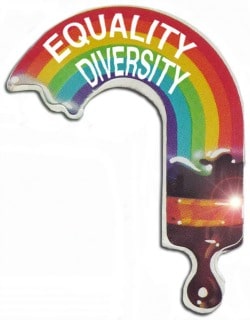5 Ways of Working with Diversity
Free Handout Download
We live in a diverse society, and in order to counsel ethically and effectively, it is important that we are mindful of how diversity and difference impact on our clients, our profession, our own lives and the therapeutic relationships we form with clients. This understanding helps us to navigate and work with the challenges and the benefits which inevitably exist within a diverse society. So what exactly do we mean when we talk about equality and diversity in counselling?

Free Handout Download
Diversity is often understood to refer to the presence of particular differences between individuals in a group of people or a society. The most prominently recognised types of difference are sometimes called “The Big Seven”. They are:
This list is increasingly seen as limited in its scope, and not necessarily inclusive of all the ways in which difference manifests in 21st century Britain. LGBTQ+ diversity, ethnicity, neurodiversity, family background (e.g. adoption or non-conventional family background), heritage and culture, regional differences, first language, and complexities of societal privilege are not comprehensively reflected in this list.
Equality is the principle that every person should be treated fairly and equally. This is an extremely important value for the counselling profession to uphold at all levels.
The most up-to-date BACP Ethical Framework highlights that we not only have a duty to demonstrate equality and respect diversity in our interactions with clients, but we also must uphold these values in relation to our colleagues. This extends to counselling organisations, colleges and universities too. Awareness of equality and diversity in counselling touches on the ethical principles of respect and justice outlined in the framework:
Diversity and difference in the therapeutic relationship can create challenges to the therapeutic relationship and may present barriers to relating. Potential issues include:
A client may wish to talk about attitudes, customs or cultural references which are unfamiliar to the therapist. In cases where there is a lack of cultural knowledge on the part of the therapist, it is important that the therapist does not rely on the client to educate them. Undertaking professional development around working with particular client groups is likely to be beneficial, and it is also important to remember that we cannot know everything – developing a strong therapeutic bond with a client can often be enough to explore at depth without having to understand all the ins-and-outs of the client’s cultural background. Additionally, a client may choose a therapist who they feel is likely to be a close cultural match, or who specialises in issues relating to particular cultures. As therapists, we trust in the client’s ability to autonomously select a route through therapy which will best support their journey.
Not all buildings/therapy spaces are accessible for all clients. This can create a very real, physical barrier to relating. The BACP Ethical Framework stipulates that we should “make adjustments to overcome barriers to accessibility, so far as is reasonably possible, for clients of any ability wishing to engage with a service.” (BACP, 2018, p. 20).
Interpreters may be necessary for those for whom English is not a first language, or for clients who are hearing-impaired and wish to access counselling. Challenges arising from the use of interpreters include the necessary adjustments to confidentiality agreements to include the interpreter, as well as potentially less fluid communication between therapist and client and the possibility that some meaning could be ‘lost in translation’, particularly subtleties of inflection and emphasis. Specialist services exist for clients with language needs, including bilingual therapists and counsellors who are able to use sign language to work directly with hearing-impaired clients.
Diversity does not necessarily create barriers to relating; in fact, it may be that speaking with a therapist from a different background or perspective offers something valuable to the client. For example, a client who is experiencing difficulties with aspects of their culture or beliefs may find it beneficial to talk with somebody who is completely unconnected to the issues they are bringing. Additionally, somebody may wish to work with a therapist of a different gender, age or with another difference in order to gain a fresh perspective or address relational patterns in the therapeutic work.
We all have unconscious biases and it is likely that on some level we will sometimes make assumptions about our clients based on their characteristics, backgrounds and even their looks. These assumptions are a response to our experiences, or introjected values, and if left unexamined and unscrutinised, may cause difficulties or even damage the therapeutic alliance.
It is important that in our personal development we strive to recognise what assumptions and beliefs we hold regarding difference and diversity, and to be mindful of how they could impact the way we interact with clients. Supervision and an ongoing process of personal reflection are both vital for developing and maintaining good standards of practice, and nurturing our therapeutic relationships when working with difference.
5 ways of working with diversity
BACP (2018) Ethical Framework for the Counselling Professions [Online]. Lutterworth: BACP. Available from: <https://www.bacp.co.uk/events-and-resources/ethics-and-standards/ethical-framework-for-the-counselling-professions/> [Accessed 05 July 2018].
This article was written for Counselling Tutor by Erin Stevens.
Notice any broken link or issues with this resource? Kindly let us know by email
Email us